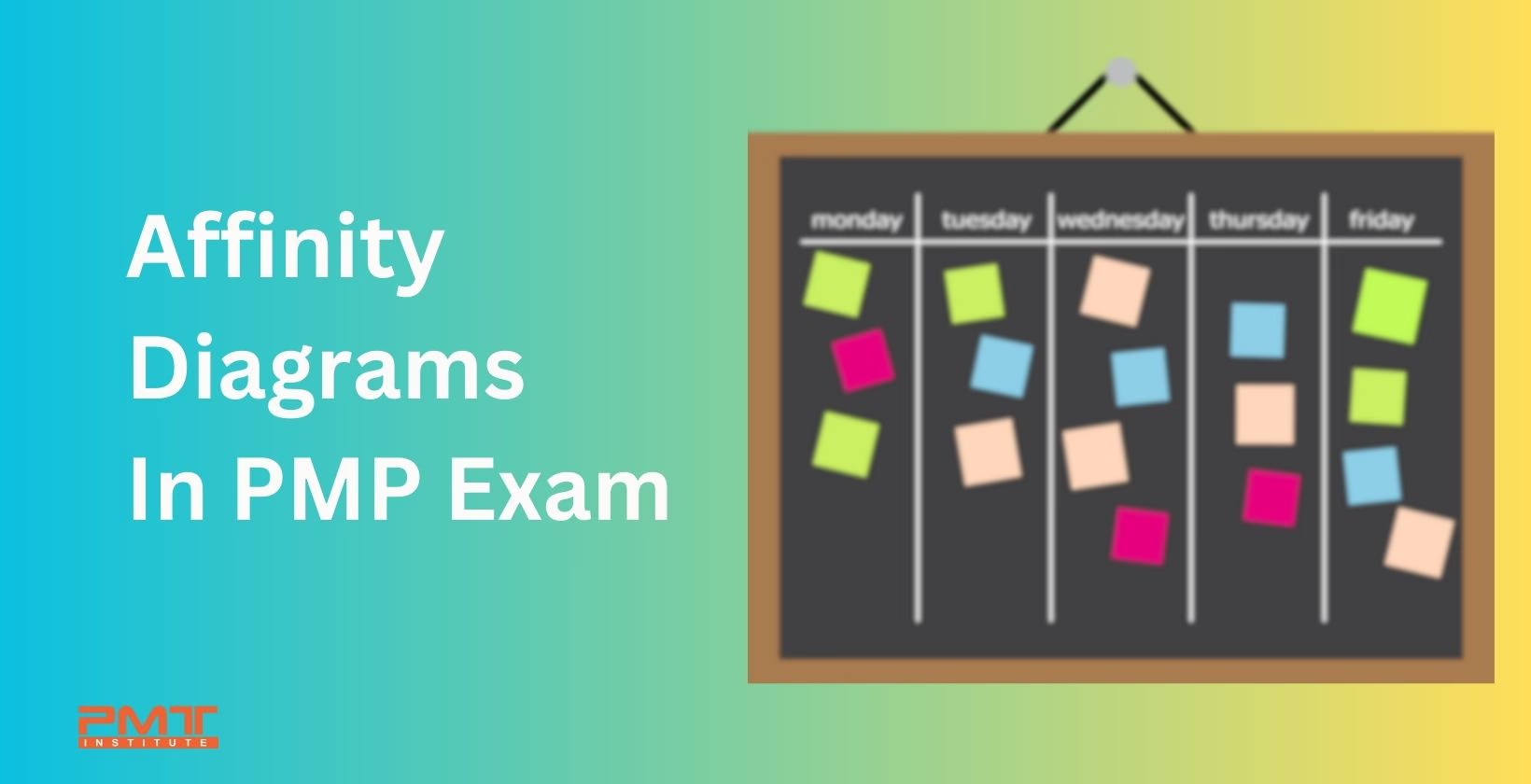What Is Affinity Diagram in Project Management (PMP)? Examples, Creation Process, Use & Benefits
Published:
Updated:

PMP® certified professionals understand the importance of utilizing data in project management. However, they also recognize that the data provided or collected for a project may not always be easily understood or relevant to the project's objectives. To overcome this challenge, they use tools like affinity diagrams which provide a solution for data-related issues and promote teamwork and collaboration during the project.
Table of Contents
What are Affinity Diagrams?
An Affinity Diagram, also known as an Affinity Map, is a visual tool to organize information. It is a useful technique for organizing and structuring large amounts of data, ideas, or facts by grouping them into common themes. This process helps the team to develop new ways of processing complex issues and finding innovative solutions.
What is Affinity Mapping?
It is the process of creating an Affinity Diagram. It is a powerful tool for improving team collaboration by harnessing everyone's best ideas. After the team gathers facts or brainstorms ideas, they work together to organize the data. Involving others in the organization process helps to better understand the information before working towards solutions.
When to Use an Affinity Diagram
Following are some of the times that you have to use affinity diagrams in a project.
Difficulty in narrowing down a solution to a problem: When you are finding it hard to narrow down a solution to a problem, it may be because you have too many facts or opinions and need more structure. An Affinity Diagram can make information more digestible.
Analyze large amounts of data: The ability to group information into common themes makes it easy to analyze large amounts of data.
Find a solution to a difficult problem: By grouping information into themes, teams can see patterns and connections that were previously hidden, leading to new and innovative solutions.
Sort a large number of ideas by theme: Affinity diagrams make it easy to sort a large number of ideas by theme, making it easier to find the most relevant ideas for your project.
Visualize and process information: The visual nature of the diagram makes it easy to visualize and process information, leading to better understanding and decision-making.
Collaborate on solutions: Affinity diagrams are a collaborative tool that allows teams to work together to find solutions by sharing ideas and discussing information in a structured and productive way.
Steps to Create an Affinity Diagram
Following are the steps to create affinity diagrams from scratch.
Choose a Topic
The first step in creating an affinity diagram is to clarify the topic that needs to be organized or consolidated. This could be anything from user research to improving marketing strategy or sparking ideas for the next project. Choosing a topic that would benefit from organizing the information differently is important. This will ensure that the affinity diagram is useful and relevant to the project at hand.
Create a Cross-Functional Team
Forming a cross-functional team to brainstorm and find the best grouping methods for the information is essential. A cross-functional team helps you look at your data from various perspectives because each team member brings unique skill sets and experiences.
This will help identify different grouping methods that may be more effective than others. For example, one team member may default to grouping ideas by "idea type," while another team member may find more effective grouping methods like "implementation requirements."
List Out Facts or Ideas
Use a brainstorming template to organize thoughts or ideas and turn them into actions. Make sure each list item is a singular idea or thought so that you can group ideas based on their unique characteristics. For example, if you're trying to brainstorm ideas to improve customer relationships, your initial idea list might include the following:
-
Targeted content.
-
Social media posts.
-
Upgraded CRM software.
-
A more direct sales strategy.
-
A loyalty program.
-
An email newsletter.
Sorting Items by Category
Categorizing items based on logical themes is crucial in understanding the information presented in the affinity diagram. By grouping similar ideas or facts together, it becomes easier to identify patterns and connections. This, in turn, helps to make sense of the data and draw relevant conclusions.
The way in which items are grouped can greatly impact how the information is understood. For example, grouping items by the person who came up with the idea may provide little insight into the product development process. However, grouping items by the complexity of the creation process or the impact the idea will make can provide more valuable information. It's important to choose a grouping method that will help you understand the information better and push your ideas forward.
Choosing the right categories can greatly impact the decision-making process. For example, if you're trying to improve customer relationships, you can group the ideas by internal vs. external efforts. However, this grouping likely won't help you narrow down your choices. Instead, group your ideas by how complex the creation process will be or by the impact the idea will make. This way, you can determine which idea will be the most logical to act on.
Creating an Action Plan
Affinity diagrams can be used to find answers and develop action plans. The insights from the affinity diagram can be used to identify the most effective ideas or solutions to a problem.
It is important to take action based on the insights gained from the affinity diagram.
The affinity diagram is not just a tool for organizing information but also for finding answers and taking action. Without taking action, the insights gained from the affinity diagram are of little value.
Once you have taken the insights from Affinity diagrams, it’s time to move forward with an action plan which is essential for the project development.
Examples of Affinity Diagrams in Project Management
For your convenience, we have shared some examples that will help you understand Affinity Diagrams in PM.
Affinity Diagram in Product Design
A product development team is responsible for developing a company's product. The team begins by brainstorming a large number of ideas for features and functions that the product should have.
The team then uses an affinity diagram to organize these ideas into related groups. This helps the team see the connections and patterns between ideas and allows them to determine which ideas are the most important for the project's success. The team can use this information to determine which ideas should be pursued and which ones to put aside.
Affinity Diagram for Problem-Solving
A company that manufactures products is experiencing high levels of defects. To find the source of the issue, a team is formed. The team brainstorms a wide range of possible causes. The team then uses an affinity diagram to group these ideas into similar groups. An example is equipment ideas being grouped while manufacturing process ideas might be separated. This allows the team sees the connections and patterns between ideas and helps them identify the most likely culprits. The team can use this information to help them focus their efforts on the most promising solution.
Affinity Diagram in Marketing
A marketing team is charged with creating a new campaign for a company. The team brainstorms a lot of ideas for messages, themes, and strategies. The team then uses an affinity diagram to group these ideas into similar groups.
An example is that ideas related to the target audience might be placed together while ideas related to the product might be put in separate groups. This allows the team to see connections and patterns between ideas and helps them determine which ideas will be most effective in reaching their target market. The team can use this information to create a cohesive, effective advertising campaign.
Benefits of Using Affinity Diagrams
Some of the benefits of using these diagrams are as follows.
-
Affinity diagrams help teams to come together and discuss ideas and information in a structured and productive way.
-
The visual nature of the diagram makes it easy to present information to others clearly and concisely.
-
By grouping information into themes, teams can see patterns and connections that were previously hidden, leading to new and creative solutions.
Conclusion
Using an affinity diagram is a great way to bring everyone's ideas to the table and develop an inclusive and effective solution. It helps teams to work together, sort facts, and gain a better understanding of the information before working toward solutions. Whether you're looking to improve a strategic plan, develop a new product, or find answers to a difficult problem, using an affinity diagram will definitely help your workflow.


